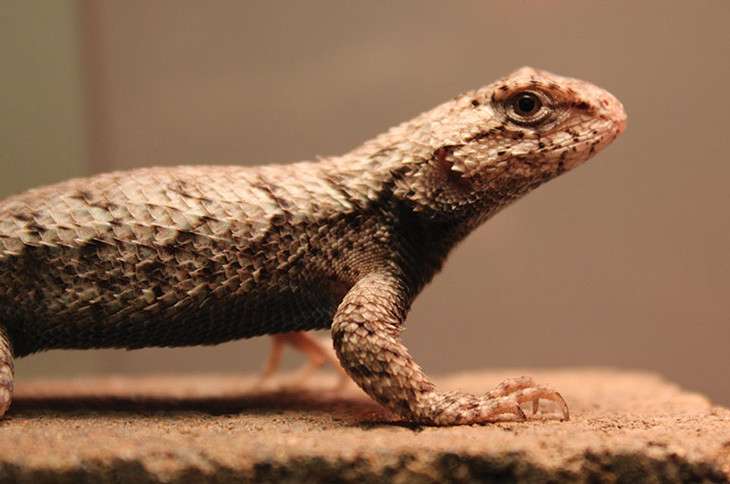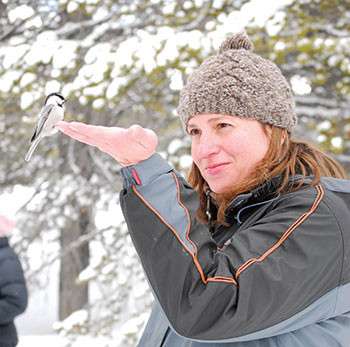Need directions? Ask a lizard

You come out of an airport and get into a cab. You give the driver your destination and expect that you will be taken to the correct place. Ever wonder how the cabdriver is able to do that?
In the days before GPS you might have assumed the driver was very experienced, or a native of the area. In fact, a study of London cab drivers once showed that experienced cabbies actually have larger hippocampi than other people. Turns out a well-developed hippocampus—that part of the brain that deals with both memory and spatial navigation—is crucial for finding one's way around.
In the animal world, having a good sense of direction can be a matter of life and death. "It can affect territoriality, mate choice, navigation, food acquisition, and many other ecologically relevant behaviors," says Lara LaDage, assistant professor of biology at Penn State Altoona.
LaDage studies lizards, including the Eastern Fence lizard and the side-blotched lizard. A side-blotched lizard has its own area, anywhere from twenty to forty square meters, and defends that area. How do they know where the boundaries of their territory are? Some scientists did not believe that lizards had the ability for spatial memory, but in a 2012 study LaDage and colleagues used the Barnes maze, a test for spatial memory, to find that "side-blotched lizards do possess the ability to engage spatial memory when navigating to a goal."
Not all of LaDage's studies involve mazes. She also studies the physical hippocampus itself, looking at both hippocampal volume and types of hippocampal neurons. To examine the neurons requires sectioning the brain, staining the sections, and looking at them under a microscope. The sectioning process is very precise, as she describes it, "at minus-20 degrees on a chuck [a stable base], using something akin to a tiny lunchmeat slicer."

Each piece is then stained with a specific stain, depending on what the researcher is looking for. LaDage explains, "A Nissl stain marks all neurons within the structure. New neurons are visualized with immunohistochemistry, staining a protein called doublecortin, which is only expressed on new, migrating neurons."
In this case, new neurons—evidence of neurogenesis—are exactly what LaDage is looking for.
Neurogenesis has been a topic of hot debate for over half a century. In fact, until biologist Joseph Altman's work in the 1960s it was widely accepted that adult mammal brains were not capable of neurogenesis. Although it was well known that lizards could remodel their brains after injury, humans, or other mammals, didn't seem to be able to do the same. Altman's research was originally ignored but by the 1990s, LaDage says, other researchers had proved him right.
She resists any insinuation that her work with lizards could be extrapolated to humans. "At least for humans," she says, "a mammalian model species would be the most likely comparison." But, she adds, "we still don't fully understand what the function of neurogenesis is," so working to explain it in any species could help us learn about the why and the how of the process.
What is known, as LaDage says, is that "lizards show more neurogenesis than mammals. After injury they can remodel their brain. And we can't. Why do lizards show increased rates of neurogenesis and what is the purpose of new neurons?"
LaDage has worked with a variety of creatures, starting with her days as a Western Illinois undergrad. "I wanted to work on turtles for my honors thesis but so did everyone else. I ended up working on digger wasps. They dig burrows, lay eggs, sting grasshoppers and crickets, and collect them for food for the larvae. It entailed sitting out in the hot summer sun next to wasp nests, collecting both wasp and food upon its return, and assessing how large of prey items that wasps could carry at one time."
In graduate school, she moved to mating strategies in geckos because "females mate with multiple males and store sperm." The research question was "Are offspring more healthy if the mother can choose the better sperm?"
Most scientists would understand LaDage's response when asked what she likes best about her research: "I like the specificity and variety of what I do; every day is different." But it's more than the brain sectioning and the lizard mazes. "The most exciting part is running the statistics. This is the exact moment I can determine if my hypothesis was supported."
LaDage may not know where her research will lead her but she most certainly won't need GPS to get there.
Provided by Pennsylvania State University




















